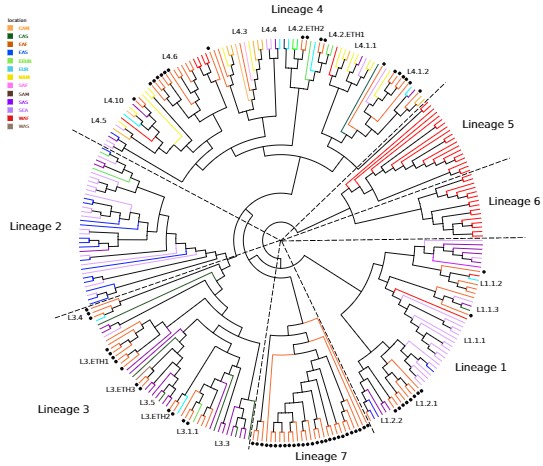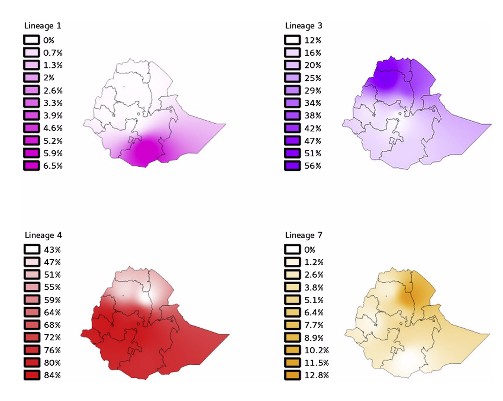“Virgin soil” hypothesis of African tuberculosis burden now challenged by new “European wave” hypothesis
Ethiopia is a hotspot for tuberculosis infection, ranking third among African countries and eighth in the world for TB burden according to the World Health Organization. But, say researchers who have analyzed the genomes of 66 TB strains and reported their findings in the Cell Press journal Current Biology Thursday, that’s most likely not because TB was absent in the country before Europeans made contact–the so-called “virgin soil hypothesis”–as had been proposed ever since colonial times. Rather, they suggest, Europeans may have introduced a new wave of disease spread by more virulent TB strains, which spread during the 20th century as countries of Sub-Saharan Africa grew increasingly urbanized.
The new genomic analysis finds a surprising amount of diversity amongst TB strains in Ethiopia. It also adds to evidence that Mycobacterium tuberculosis, the bacterium responsible for TB, originated in Africa.
“The diversity of M. tuberculosis in Ethiopia is considerably higher than is recorded in most other countries; the number of genotypes present in the population is large, and some of them have clear links with other global genotypes while others are specific to East Africa,” says Stefan Berg of the Animal and Plant Health Agency in Surrey, United Kingdom. “Before this project was initiated, this high diversity was not expected.”
“The diversity of M. tuberculosis complex in Ethiopia confirms the African origin of the disease and contradicts early notions that TB was not present in Africa before main European contact,” adds Iñaki Comas of FISABIO Public Health in Valencia, Spain. “However, it remains to be explained why high rates of infection among native people were observed after the contact.”

The findings are part of a larger effort by Comas and Berg along with colleagues in Europe and Ethiopia to understand the high rates of TB and specifically extra-pulmonary TB–a less common form of the infection affecting areas of the body outside of the lungs–seen in Ethiopia.
In the new study, the researchers analyzed a broad sample of M. tuberculosis strains collected from infected people in Ethiopia. Their analysis shows that all of the strains collected trace back to a single common ancestor with a proposed origin in East Africa. The analysis also revealed a pattern of serial introductions of TB strains into Ethiopia in association with human migration and trade.
Although more work remains, the researchers “propose that increased TB mortality in Africa was driven by the introduction of European strains of M. tuberculosis alongside expansion of selected indigenous strains having biological characteristics that carry a fitness benefit in the urbanized settings of post-colonial Africa.”

The new evolutionary analyses shed light on past epidemics of TB. They might also help to understand global trends in TB infection and perhaps even better predict the future. “Understanding factors that may have influenced the current population structure of M. tuberculosis in Africa and worldwide can potential help predicting future trends in the disease epidemiology,” Berg says.
Comas says they would now like to sequence the bacteria along with their human hosts to further investigate the biological factors underlying high rates of extrapulmonary TB in Ethiopia, which may lead to new strategies for combatting this form of disease globally. They’d also like to explore whether certain human populations are more susceptible to certain bacterial strains.
Read more: Drug-Resistant Tuberculosis Rising to Global Threat – WHO
The report, “Population Genomics of Mycobacterium tuberculosis in Ethiopia Contradicts the Virgin Soil Hypothesis for Human Tuberculosis in Sub-Saharan Africa” was published in the journal Current Biology.
By Joseph Caputo
With images from the report and WHO (WHO/P. Virot)
